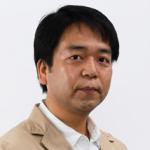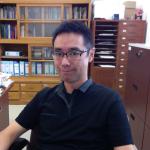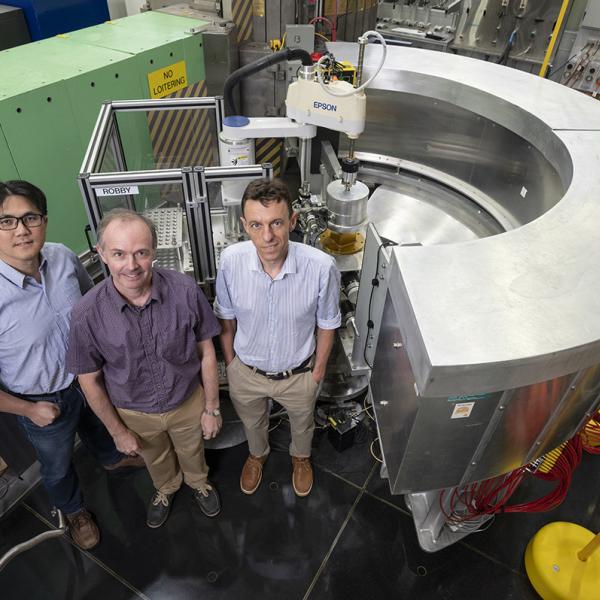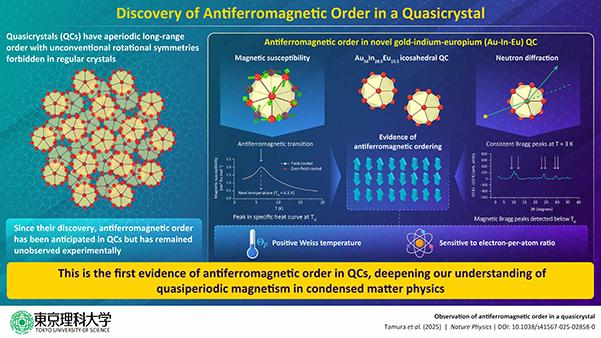
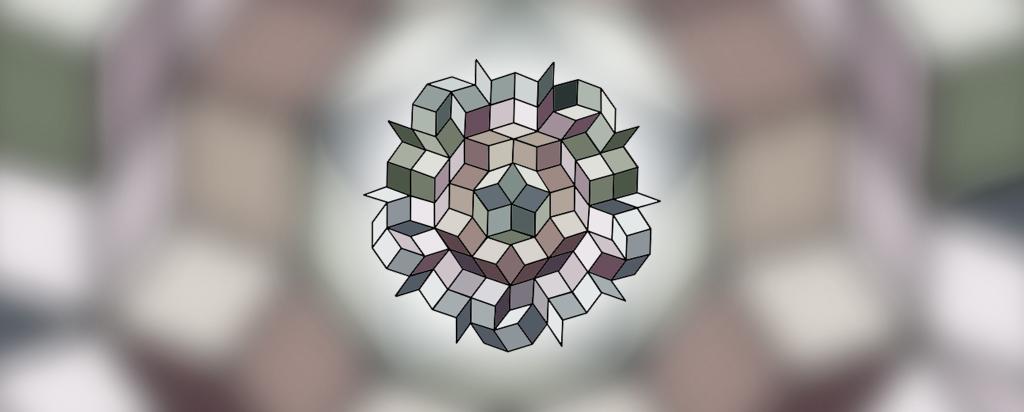
Published on the 20th May 2025 by ANSTO Staff
ANSTO was part of a team led by researchers from Tokyo University of Science and Tohoku University, who have discovered antiferromagnetism in a real icosahedral quasicrystal (iQC), reinvigorating the search for antiferromagnetic quasicrystals.
Quasicrystals (QCs) are fascinating solid materials that exhibit an intriguing atomic arrangement. Unlike regular crystals, in which atomic arrangements have an ordered repeating pattern, QCs display long-range atomic order that is not periodic. Due to this ‘quasiperiodic’ nature, QCs have unconventional symmetries that are absent in conventional crystals.
Since their discovery in 1984, which was recognized by the Nobel Prize in 2011, quasicrystals have captured considerable attention among condensed matter physics researchers not only for their potential to realize unique quasiperiodic magnetic order but also for their possible applications in spintronics and magnetic refrigeration.
Even though ferromagnetism was recently discovered in the gold-gallium-rare earth (Au-Ga-R) icosahedral QCs, its observation may not be entirely unexpected in the condensed matter physics community, as translational periodicity is not a prerequisite for the emergence of ferromagnetic order. In contrast, antiferromagnetism, the other fundamental type of magnetic order found in nature, is inherently more sensitive to crystal symmetry.
Although its establishment in certain types of QCs has long been anticipated by theoreticians, it has not been directly observed in real QCs. Experimentally, most magnetic iQCs exhibit spin-glass-like freezing behaviour, with no sign of long-range magnetic order, which has led researchers to question whether antiferromagnetism is even compatible with quasiperiodicity—until now.
The research team was led by Professor Ryuji Tamura from the Department of Materials Science and Technology at Tokyo University of Science (TUS), along with Mr. Takaki Abe, also from TUS, Professor Taku J. Sato from Tohoku University, and Professor Max Avdeev from the Australian Nuclear Science and Technology Organisation and The University of Sydney.
“As was the case for the first report of antiferromagnetism in a periodic crystal in 1949, we present the first experimental evidence of antiferromagnetism occurring in an iQC,” says Prof. Tamura. Their study was published in the journal Nature Physics.
“This is a very important development, that is attracting considerable scientific interest. Neutron scattering experiments on the Echidna instrument at the Australian Centre for Neutron Scattering provided definitive evidence of long-range antiferromagnetic ordering in the Au–In–Eu sample”, said Prof Avdeev.
“Neutron diffraction will be equally important in the studies of other magnetic quasicrystals in the follow-up studies.”
Building upon their recent discovery of ferromagnetism in the Au-Ga-R iQCs, in this study, researchers identified a novel Tsai-type gold-indium-europium (Au-In-Eu) iQC, exhibiting 5-fold, 3-fold, and 2-fold rotational symmetries.
The team conducted a series of bulk property measurements and neutron experiments to examine its magnetic nature. Magnetic susceptibility measurements showed a sharp cusp at a temperature of 6.5 Kelvin (K) for both the zero-field cooled and field-cooled conditions, consistent with an antiferromagnetic transition. Specific heat measurements also showed a peak at the same temperature, verifying that the cusp is due to a long-range magnetic order.
To further validate their results, the team performed neutron diffraction measurements of the iQC at temperatures of 10 K and 3 K. They observed additional magnetic Bragg peaks at 3 K, which consistently showed an abrupt increase around the transition temperature of 6.5 K in temperature-dependence measurements, providing the first clear evidence of long-range antiferromagnetic order in a real QC.
As to why the Au-In-Eu iQC hosts an antiferromagnetic phase, the researchers found that, unlike previously studied iQCs, which commonly exhibit a negative Curie-Weiss temperature, this novel iQC has a positive Curie-Weiss temperature.
Interestingly, they also discovered that with a slight increase in the electron-per-atom ratio through elemental substitution, the antiferromagnetic phase disappears and the iQC shows spin-glass behaviour, much like previous iQCs. This suggests that iQCs with a positive Curie-Weiss temperature favour antiferromagnetic order establishment, opening new avenues for future studies to develop novel antiferromagnetic QCs by controlling the electron-per-atom ratio.
“This discovery finally resolves the longstanding issue of whether antiferromagnetic order is possible in real QCs,” remarks Prof. Tamura. “Antiferromagnetic QCs could enable unprecedented functions, such as ultrasoft magnetic responses, and will bring about a revolution in spintronics and magnetic refrigeration in the future.”
The researchers emphasize the United Nations’ sustainable development goals (SGDs) – affordable and clean energy (SDG 7), industry, innovation, and infrastructure (SDG 9) towards building energy-efficient electronics. Solving a decades-long mystery, this discovery not only reinvigorates the search for unexplored antiferromagnetic QCs but also opens a new research field of quasiperiodic antiferromagnets, whose implications extend far beyond spintronics.
Thanks to Tokyo University of Science for providing the information used in this article.
